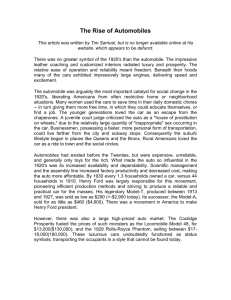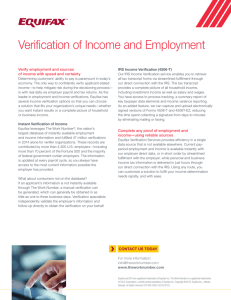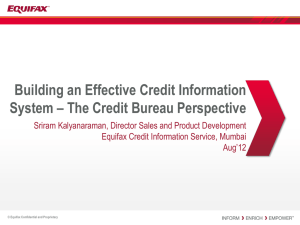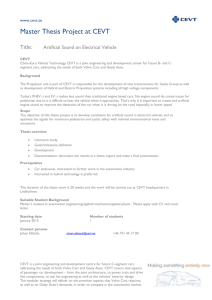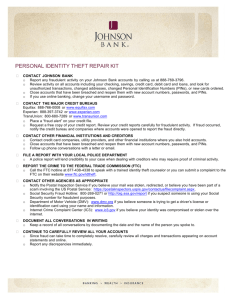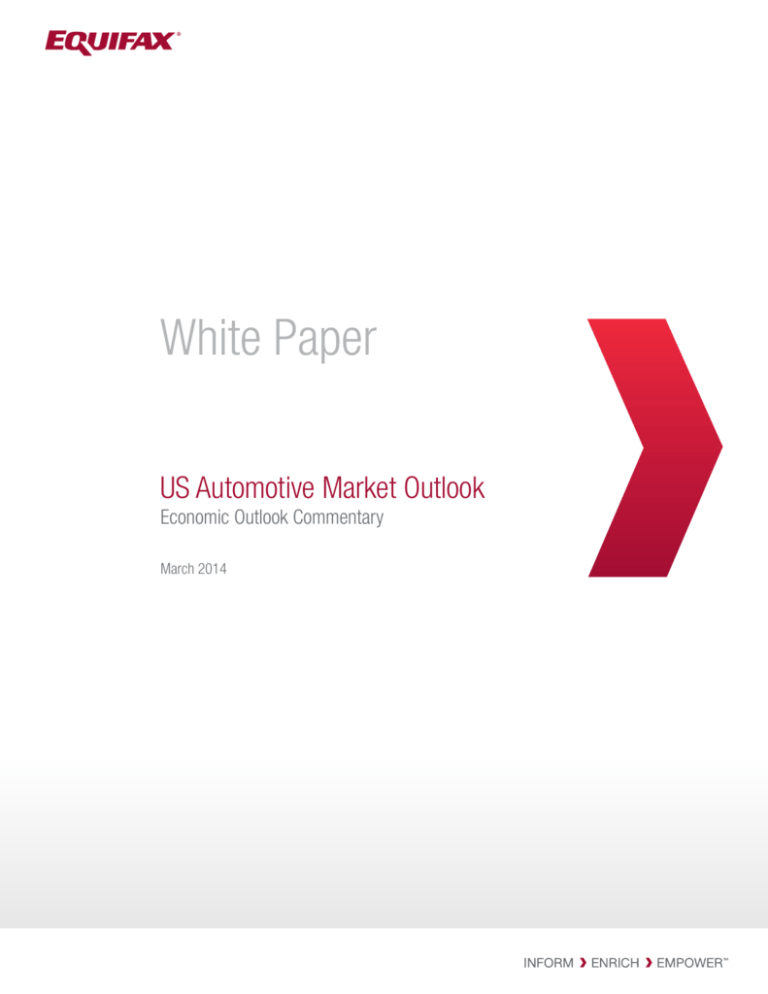
US Automotive Market Outlook
Economic Outlook Commentary
March 2014
About Equifax
Equifax is a global leader in consumer, commercial and workforce information solutions
that provide businesses of all sizes and consumers with insight and information they can
trust. Equifax organizes and assimilates data on more than 600 million consumers and
81 million businesses worldwide. The company’s significant investments in differentiated
data, its expertise in advanced analytics to explore and develop new multi-source data
solutions, and its leading-edge proprietary technology enable it to create and deliver
unparalleled customized insights that enrich both the performance of businesses and the
lives of consumers.
Headquartered in Atlanta, Equifax operates or has investments in 18 countries and is a
member of Standard & Poor's (S&P) 500® Index. Its common stock is traded on the
New York Stock Exchange (NYSE) under the symbol EFX. In 2013, Equifax was named
a Bloomberg BusinessWeek Top 50 company, was #3 in Fortune's Most Admired list
in its category, and was named to InfoWeek 500 as well as the FinTech 100. For more
information, please visit www.equifax.com.
www.equifax.com
Equifax Inc. | US Automotive Market Outlook | ii
US Automotive Market Outlook
Introduction
Looking back, 2013 was a strong year for the auto industry. According to the Bureau
of Economic Analysis total new sales were 15.5 million units, up more than 1 million
from the previous year and more than 5 million units from the recession low in 2009
(the worst sales year since 1982).
This document looks ahead to consider key factors to watch in the future, including
unique trends and statistics that could easily influence the market and drive auto sales
higher or lower than industry expectations.
Encouraging signs that support
higher-than-expected auto sales
For starters, there is a tremendous amount of pent-up demand. Despite the 15.5
million new vehicles sold in 2013, there remains a huge gap between the number
of new cars that should have been sold based on trends prior to the recession and
what actually sold. The shaded area in Figure 1 shows this pent up demand. We
estimate it to be in excess of 26 million units as of year-end. This is the primary
momentum driver in the forecast.
Equifax Inc. | US Automotive Market Outlook | 1
New Auto Sales in US (1000s, NSA)
20
18
16
14
12
10
8
6
4
2
2012
2008
2004
2000
1996
1992
1988
1984
1980
1976
0
Figure 1. Source: U.S. Bureau of Economic Analysis; Equifax
Another positive influence on future auto sales are scrappage rates, which are expected
to increase in 2014 as cars continue to age out of circulation.
Consider the life cycle of an automobile. A new car is created and sold or leased. This
car is driven for some period of time until it is replaced with a newer model. The car
that is replaced is resold and the process continues until the value of the car as a
whole is less than the sum of its parts. At this point the car is destroyed for scrap. The
ratio of cars that are scrapped to the total cars on the road is called the scrappage
rate, and it effectively measures how many cars are removed from circulation in a
given year. Generally, the higher the scrappage rate, the greater the number of new
cars that will be sold, all else equal.
Another contributor to higher-than-expected auto sales is the combination of a
strengthening economy, low interest rates and new technology, which will entice
consumers who have been “on the fence.”
Most economists are predicting stronger economic growth in 2014. Unemployment
is expected to continue declining, the housing market should continue to pick up and
consumer confidence will likely continue to rise. Interest rates for new car purchases
remain at record lows with the average rate for near prime consumers around 4
percent. This in and of itself suggests that 2014 will be a good time to buy a new car.
There is another factor to consider, and that is the ongoing inclusion of new technology
and new models in the industry. According to LMC Automotive, auto makers are
planning to introduce in excess of 130 new models in 2014-2015, more than were
Equifax Inc. | US Automotive Market Outlook | 2
introduced in total over 2009-2011. Features like integrated Bluetooth and rear-view
cameras, once only available on luxury cars, are becoming standard on many economy
models.
Pay attention to these warning flags
that could stall sales
Despite the many positive economic and industry indicators supporting stronger than
expected auto sales, there are a few trends that could dampen the outlook if they
continue.
To start, auto density has fallen and it can't get up. Auto density—the number of
automobiles per household or vehicles per driver—is one way to measure the demand
for automobiles in the United States. Prior to 2006, this ratio was increasing but has
been sharply declining since then [see Figure 2]. This is particularly problematic as a
small change in this density has a large impact on the number of new cars sold—a 1
percent change in this ratio can equate to as many as 1 million new car sales annually.
If this decrease in density is structural and not cyclical, it would present a steep hurdle
to growth.
Density Measured by Number of Vehicles per Household (NSA)
2.10
2.05
2.00
1.95
1.90
Figure 2. Source: U.S. Census Bureau; Federal Highway Administration; Equifax
Equifax Inc. | US Automotive Market Outlook | 3
2011
2010
2009
2008
2007
2006
2005
2004
2003
2002
2001
2000
1999
1998
1997
1996
1995
1994
1993
1992
1991
1990
1.85
Here’s another relevant trend to watch. Cars are being driven less and are lasting
longer which makes used cars a serious alternative to new cars.
Prior to the recession and based on the previous recession’s experience, conventional
wisdom suggested that vehicle sales were unlikely to drop much below 16 million units
per year. While this was obviously incorrect, it's nonetheless understandable when
looking at auto sales from 1999-2007. Slicing the data another way, however, gives
a more sobering picture. Figure 3 shows the annual number of new cars purchased
per 100,000 licensed drivers. As the trend line shows, this rate has been steadily
decreasing since 1976, and sales in 2013 are very near their expected value.
New Auto Sales per 100,000 Licenced Drivers (NSA)
11
10
9
8
7
6
5
2012
2008
2004
2000
1996
1992
1988
1984
1980
1976
4
Figure 3. Source: U.S. Bureau of Economic Analysis; Federal Highway Administration; Equifax
Additionally, There has been a decline in the miles driven [see Figure 4], and
improvements in the manufacturing process have dramatically improved the quality of
cars created thereby extending their reliability. This combination makes it very difficult
for a consumer to justify pulling the trigger on a new car compared to either keeping
their existing car or going with a low-mileage used car.
Equifax Inc. | US Automotive Market Outlook | 4
Annual Miles Driven per Licenced Driver (1000s, NSA)
15
14
13
12
11
Figure 4. Source: Federal Highway Administration; Equifax
The next factor is somewhat sobering. Americans are falling out of love with automobiles.
Demographic trends are not moving in favor of the automobile. Urbanization is shifting
the population to areas where owning a car is unnecessary—public transportation
and ride share services like ZipCar are a more cost effective way to satisfy the needs
of many city dwellers.
Surveys, such as those by the University of Michigan’s Transportation Research
Institute (UMTRI), have shown that many Millennials—the generation born between
the early 1980s to the early 2000s—are much less interested in owning a car than
their parents and grandparents, viewing them as nothing more than a way to get from
point A to point B. For many, the effects of the Great Recession coupled with increased
student loan debt have delayed the purchase of a new car, perhaps indefinitely.
This shift in attitude is not confined to the younger generations. Baby Boomers are
beginning to retire and will no longer have the desire to purchase a new car every four
years. Car manufacturers are keenly aware of the changing marketplace but it may
take time to find and implement a successful strategy.
Last, auto financing demand is rising faster than the demand for new and used cars.
More than ever before, consumers are considering the cost of financing a car when
making a decision to purchase, and the trends are in their favor. Post-recession, prime
and near-prime credit car purchasers have had a fairly easy time finding great deals on
car loans, but the offerings have not been as plentiful for those with recent severe credit
problems stemming from foreclosures, long-term unemployment or other set-backs.
Equifax Inc. | US Automotive Market Outlook | 5
2014
2010
2006
2002
1998
1994
1990
1986
1982
1978
1974
1970
10
Auto lenders, particularly non-bank finance companies, are starting to look for ways to
expand credit availability to those with less-than-stellar credit. Appetite for auto loan
securitizations among Wall Street investors is also showing nascent signs of growth,
which may increase access to financing while also creating more demand for detailed
data on consumers, their capacity to carry new debt and their credit behaviors.
Conclusion: Sales outlook is good, but
guard against evolving barriers to growth
Widen your target audience to include low-risk subprime consumers
While annual auto sales have yet to return to pre-recession highs, forecasts for 2014
are positive, with year-over-year growth expected. What’s more, key economic and
industry indicators are showing favorable activity that could push sales above current
projections. But, the path ahead is not perfectly smooth as evolving trends, such as
the increasing indifference of Millennials and Baby Boomers toward new cars, could
threaten long-term growth.
Moving forward, the auto industry should consider expanding its customer base by
reaching out to the many formerly prime consumers who were negatively impacted
by the 2009 recession. As this population recovers financially in step with the larger
economy, it could present new opportunities for the industry. To do this, lenders should
consider accessing deeper consumer credit insights—beyond a traditional credit
score or report—from alternative data sources such as pay TV and utility bill payments
and other sources. By better understanding how consumers pay their fixed bills, auto
businesses can more confidently assign risk to more consumers, expand their target
audience and grow their customer base and auto sales well into the future.
The opinions, estimates and forecasts presented herein are for general information use
only. This material is based upon information that we consider to be reliable, but we do
not represent that it is accurate or complete. No person should consider distribution of
this material as making any representation or warranty with respect to such material
and should not rely upon it as such. Equifax does not assume any liability for any loss
that may result from the reliance by any person upon any such information or opinions.
Such information and opinions are subject to change without notice. The opinions,
estimates, forecasts, and other views published by Equifax Economic Insights group
represent the views of that group as of the date indicated and do not necessarily
represent the views of Equifax or its management.
Equifax Inc. | US Automotive Market Outlook | 6
Contact Us Today
For more information, please visit
www.insight.equifax.com/automotive
There are references throughout this publication/website to various trademarks or service marks and these, whether registered or not,
are the property of their respective owners. Equifax is a registered trademark of Equifax Inc. Inform > Enrich > Empower is a trademark of
Equifax Inc. Insert all other trademark, registration, text here. Copyright © 2014. Equifax Inc., Atlanta, Georgia. All rights reserved.
Equifax Inc. | US Automotive Market Outlook | 7
www.equifax.com
EFX-ABC-0000-03/11/14

